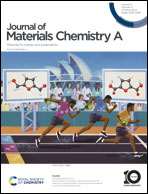Tuning the LiF content in the SEI by engineering the molecular structures of porous organic polymers for solid-state lithium metal batteries†
Abstract
LiF, which is considered as a key component of the solid electrolyte interface (SEI), can promote the uniform deposition of lithium. However, excessive LiF will limit the transport of lithium ions (Li+) in the SEI, resulting in low coulombic efficiency and lithium dendrite growth. Regulating the LiF concentration in the SEI is challenging but critical to the development of solid-state lithium metal batteries (SSLMBs). Herein, we synthesized porous organic polymers (POPs) that can be flexibly modified at the molecular level. These modified POPs (denoted as POPs-X-FP, X = 2, 3, 4) are added into a PEO electrolyte as fillers to form composite solid electrolytes (denoted as CSE-X-FP, X = 2, 3, 4, respectively). CSE-X-FP have different catalytic decomposition capabilities of TFSI− anions in the electrolyte due to the different fluorine atom substitution positions on the benzene ring of the POPs. Consequently, the LiF concentration in the SEI can be optimized by tuning the fluorine atom substitution positions on the benzene rings of the POPs to boost the performance of PEO based ASSLMBs. Using the LiF optimized SEI, the LiFePO4(LFP)//CSE-4-FP//Li full cell delivered a long cycle life of 1200 cycles with an initial capacity of 160.7 mA h g−1 at 0.5C. This study provides a new strategy to regulate the LiF content in the SEI layer to boost the performance of SSLMBs.

- This article is part of the themed collection: 2023 Journal of Materials Chemistry A HOT Papers


 Please wait while we load your content...
Please wait while we load your content...